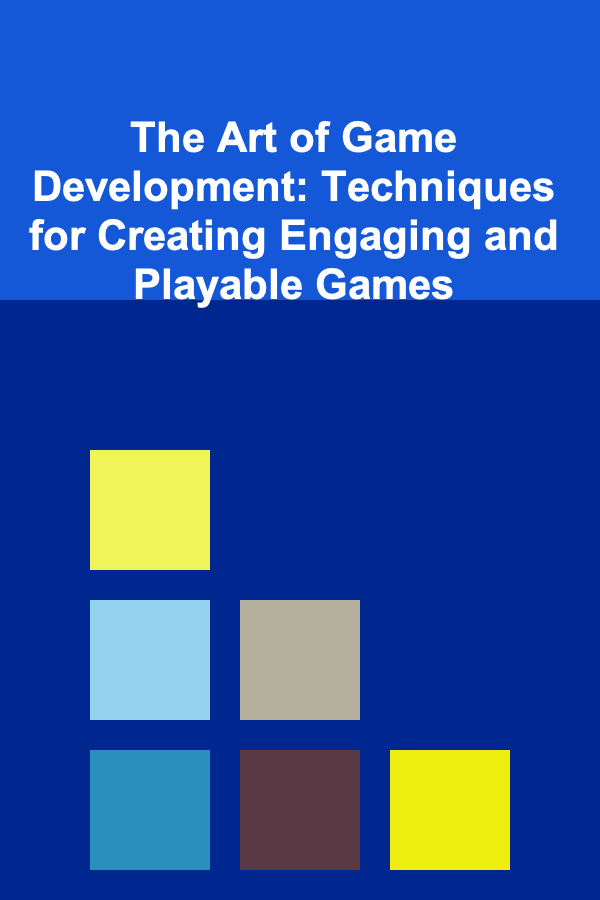
The Art of Game Development: Techniques for Creating Engaging and Playable Games
ebook include PDF & Audio bundle (Micro Guide)
$12.99$8.99
Limited Time Offer! Order within the next:

Game development is an intricate art that blends creativity, technology, and user experience design. It involves the construction of virtual worlds, the creation of compelling characters, and the development of systems that keep players engaged for hours on end. Whether you're an aspiring indie developer or part of a large studio team, understanding the fundamental techniques behind creating a great game is crucial to success.
In this guide, we'll dive deep into the art of game development, exploring key techniques and strategies that will help you create engaging and playable games. From concept to execution, we'll cover the most critical aspects that lead to a game's success.
Conceptualization: Building the Foundation
Every great game starts with an idea. However, transforming that idea into an engaging experience requires a clear vision, planning, and strategic thinking. The conceptualization phase is where you define the essence of your game, ensuring that it's not just fun but also feasible.
Define the Core Gameplay Loop
At the heart of any game is the core gameplay loop. This loop consists of actions that players repeatedly perform, and it's what keeps them coming back. Defining a satisfying gameplay loop involves considering several factors:
- Challenges: What obstacles or goals will players face?
- Rewards: What incentives will players receive for overcoming challenges? Rewards could be in-game items, new levels, or narrative progression.
- Player Engagement: How will players remain engaged and feel motivated to continue playing?
For example, in a first-person shooter, the core gameplay loop might consist of exploring environments, encountering enemies, engaging in combat, and then gaining new weapons or abilities to continue progressing.
Craft a Compelling Narrative
While not every game needs an elaborate story, narrative can significantly enhance player immersion. Even simple mechanics can feel more meaningful when embedded within a strong narrative framework. Ask yourself:
- What's the world like?
- Who are the characters, and what are their motivations?
- What problem are the players solving, and why should they care?
A compelling story provides context to the player's actions, deepening the emotional connection with the game world. A simple yet evocative plot can give a game lasting appeal, particularly in genres like RPGs, adventure games, and story-driven puzzle games.
Create a Unique Art Style
Art direction plays a huge role in setting the tone of the game. Whether you're working with realistic graphics or stylized visuals, the art style should complement the gameplay and narrative. Consider the following:
- Consistency: Ensure that the art style remains consistent throughout the game, from environments to character design to UI elements.
- Color Theory: Colors evoke emotion. Warm colors might convey urgency or danger, while cool colors might give a sense of tranquility or mystery.
- Immersion: The visual design should help immerse players in the world, enhancing their emotional connection and reinforcing the game's theme.
Gameplay Mechanics: Making it Fun and Challenging
The gameplay mechanics are the building blocks of player interaction with the game. These are the rules and systems that govern how players progress, challenge themselves, and experience the game world.
Focus on Player Agency
Players want to feel in control of their actions, and that sense of agency is vital for creating an engaging experience. The key is balancing freedom with structure:
- Challenge vs. Ability: Players should feel challenged, but they should also feel that they have the skills or tools to overcome those challenges.
- Feedback Systems: Immediate and clear feedback---whether visual, auditory, or haptic---helps players understand the consequences of their actions and gives them a sense of accomplishment.
For example, in platformers, a well-timed jump that results in overcoming an obstacle provides instant feedback, rewarding the player with progress.
Iterate on Difficulty Curve
One of the hallmarks of a well-designed game is a properly calibrated difficulty curve. Players should feel an increasing sense of challenge as they progress through the game, but it should never feel overwhelming. A well-crafted difficulty curve provides a gradual increase in complexity, so players are continually engaged without feeling frustrated.
- Introduce new mechanics gradually: Players should be introduced to new gameplay mechanics early on and given enough time to master them.
- Balanced rewards: Offering appropriate rewards at key moments (e.g., after completing tough levels or puzzles) can help alleviate the tension of increasing difficulty.
Make Controls Intuitive
Intuitive controls are critical for accessibility and player enjoyment. If players struggle to learn how to interact with your game, it can quickly lead to frustration. Whether your game is a mobile app, a PC game, or a console title, the controls should feel natural.
- Learnability: The more complex your controls, the more time you should allocate to tutorials or practice areas where players can get used to them.
- Consistency: Keep control schemes consistent throughout the game to reduce cognitive load on players. If pressing a button does something in one part of the game, it should generally do the same thing elsewhere.
Technical Considerations: Making it Run Smoothly
A playable game is a technically sound game. Regardless of how great the design or mechanics are, if a game doesn't perform well, players will quickly become frustrated. Here are some technical aspects that should be prioritized.
Optimize Performance
Performance issues such as lag, stuttering, or long loading times can hinder the player's experience. Optimizing the game's performance is a critical task, especially for larger-scale games. Key areas to focus on include:
- Frame Rate: Aim for a stable frame rate (typically 30--60 FPS), as low frame rates can make gameplay feel sluggish or jarring.
- Load Times: Players expect near-instantaneous load times. Minimizing loading screens and optimizing asset streaming (e.g., background loading) can go a long way toward improving user experience.
- Memory Management: Efficient memory use ensures that your game runs smoothly across a wide range of hardware, preventing crashes or slowdowns.
Polishing and Bug Fixing
While bugs and glitches are inevitable during development, a polished game is one with minimal errors. Every bug should be addressed and fixed, and proper testing should be conducted across different platforms and hardware. Regular playtesting and QA ensure that the game not only works but feels refined and smooth.
- Playtesting: Regular playtests help identify pain points, confusing mechanics, or unbalanced levels early on.
- User Feedback: Incorporating feedback from real players can uncover issues that you might not have noticed in development.
Audio and Sound Design: Enhancing the Experience
Audio plays a crucial role in player immersion. Well-designed sound effects and music not only provide feedback but also evoke emotion, create atmosphere, and enhance gameplay.
Create Dynamic Soundscapes
The audio should complement the visuals and gameplay. Dynamic soundscapes respond to player actions, creating a more immersive experience. Consider:
- Ambient Sound: Background noises (such as wind, water, or bustling city sounds) help make the world feel alive.
- Reactive Sound: Sound effects that change in response to gameplay, like footsteps that echo in a large hallway or the sounds of weapons firing during combat, deepen the player's immersion.
Use Music to Evoke Emotion
Music can make a dramatic impact on how a player experiences the game. The score should reflect the emotional tone of the game and evolve with player progress. For instance:
- Upbeat Themes: For fast-paced action sequences or victories, energetic music can amplify excitement.
- Somber Tunes: In emotional or tense moments, softer, slower melodies can increase tension and player investment.
Post-Launch: Keeping Players Engaged
Creating a great game doesn't stop at launch. Post-launch support, updates, and community engagement are essential to maintaining a long-lasting player base.
Regular Updates
To keep players coming back, consider introducing:
- New content: Expanding the game with new levels, characters, or story arcs can maintain interest.
- Balance Changes: Adjusting gameplay mechanics, especially in multiplayer games, to ensure fairness and avoid monotony.
- Bug Fixes: Continuous patches and updates show that you're committed to improving the game, making it feel more polished over time.
Foster a Community
Building a community around your game encourages engagement and longevity. Utilize forums, social media, and in-game messaging to create a space where players can discuss strategies, share fan content, or provide feedback.
- Multiplayer support: Incorporating multiplayer elements (co-op or competitive) can extend a game's lifespan as players return to compete or collaborate with others.
- Fan-created content: Allowing or encouraging modding can help breathe new life into your game and create a dedicated player base.
Conclusion
Game development is a multi-faceted, challenging art form that requires attention to detail, creativity, and technical expertise. By focusing on creating a compelling core gameplay loop, ensuring engaging mechanics, maintaining technical performance, and integrating immersive audio-visual elements, developers can create games that captivate and entertain. Through thoughtful post-launch support, a game can continue to evolve and remain relevant, cultivating a dedicated community and ensuring lasting success in the gaming industry.

How to Organize a Collection of Stuffed Animals
Read More
How to Store Sports Equipment Without Taking Over the Garage
Read More
How to Style Your Holiday Table with Simple Yet Elegant Decor
Read More
How to Train Your Brain to Manage Anxiety
Read More
Is Choosing Generic Medications Right for You? What You Need to Know
Read More
Exploring EV Battery Fire Safety: A Comprehensive Guide
Read MoreOther Products

How to Organize a Collection of Stuffed Animals
Read More
How to Store Sports Equipment Without Taking Over the Garage
Read More
How to Style Your Holiday Table with Simple Yet Elegant Decor
Read More
How to Train Your Brain to Manage Anxiety
Read More
Is Choosing Generic Medications Right for You? What You Need to Know
Read More